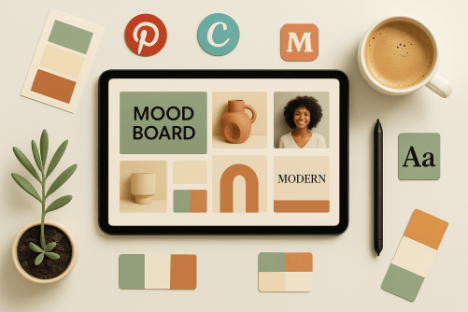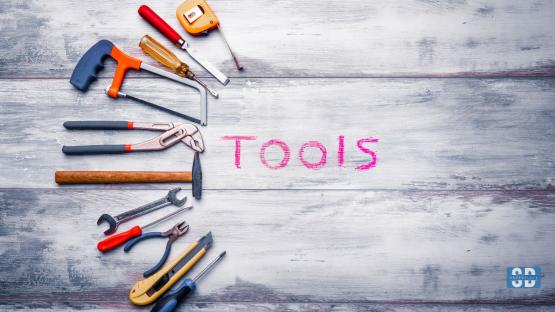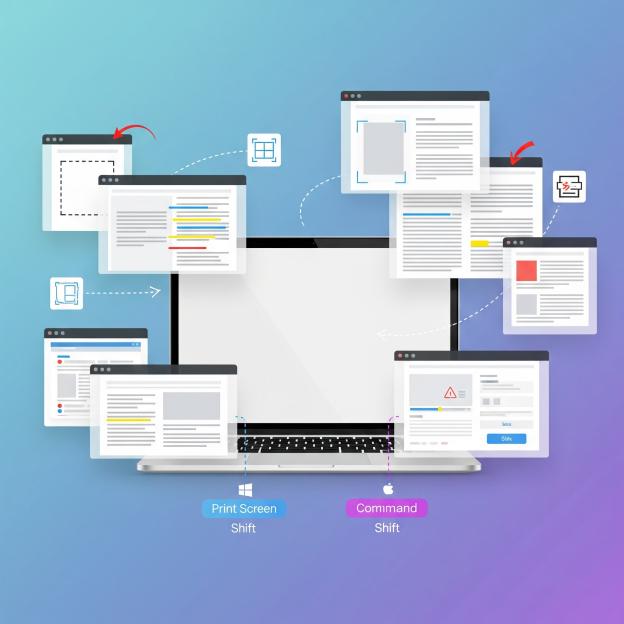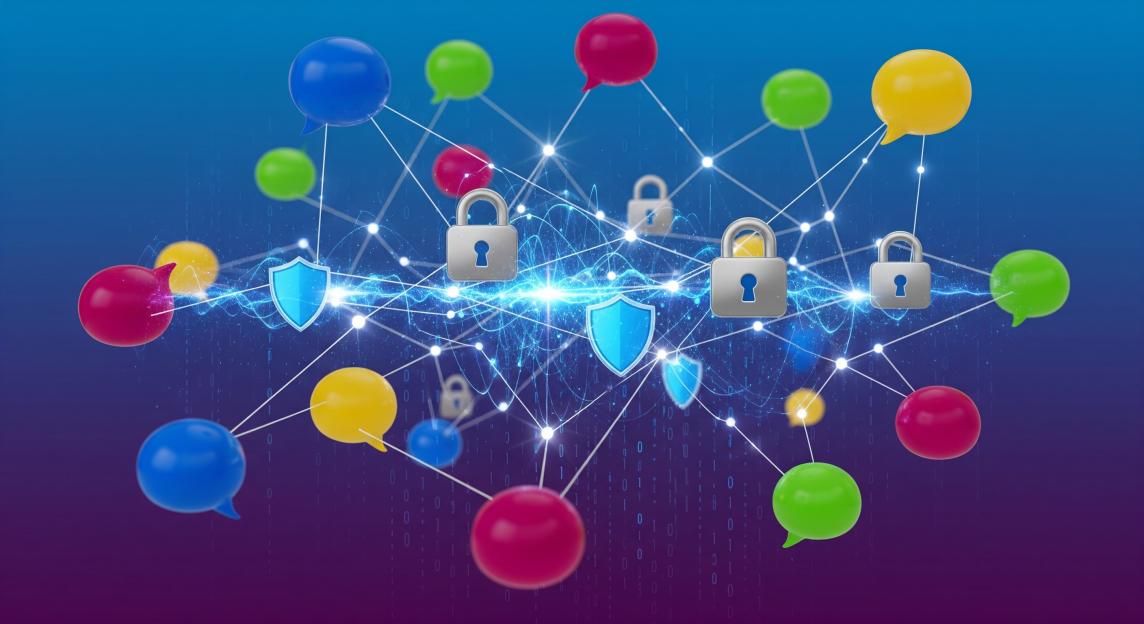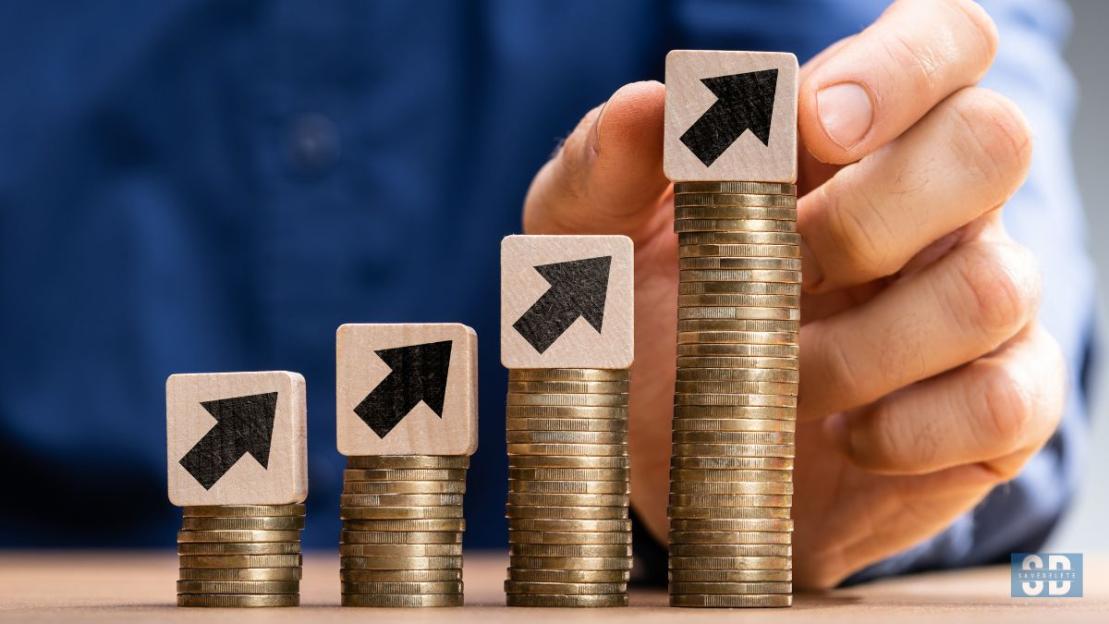Scrolling through Pinterest at 2 AM looking for that perfect aesthetic is basically a whole mood, but what if I told you there are way better apps that can actually organize your creative chaos?
Whether you’re planning your next room makeover, building a brand vibe, or just trying to get your creative thoughts together, mood board apps are literally the digital equivalent of those cork boards covered in magazine cutouts our parents used to make.
These apps are where your wildest creative dreams meet actual organization, and trust me, once you find the right one, you’ll wonder how you ever lived without it.
What Are Mood Board Apps and Why Do You Need Them?
Mood board applications are digital platforms designed to help users collect, organize, and visualize creative ideas through images, colors, textures, and text. These visual inspiration tools serve as digital canvases where creativity meets organization, allowing users to curate cohesive visual narratives for projects ranging from interior design to brand development.
In today’s fast-paced creative landscape, mood board apps have become essential tools for designers, marketers, content creators, and anyone looking to bring visual coherence to their ideas. These applications streamline the creative process by providing intuitive interfaces for collecting inspiration from various sources and organizing them into meaningful visual collections.
The primary benefits of using mood board apps include improved project visualization, enhanced team collaboration, streamlined creative workflows, and the ability to maintain consistent visual themes across multiple projects. Whether you’re working on personal creative endeavors or professional design projects, these tools provide the foundation for translating abstract concepts into tangible visual representations.
Top 15 Best Mood Board Apps for 2025
1. Pinterest â The Creative Giant
Pinterest remains the undisputed champion of visual inspiration platforms, boasting over 450 million active users worldwide. This visual discovery platform excels at helping users discover and organize creative ideas across countless categories.
Key Features:
- Extensive image database with billions of pins
- Advanced search functionality with visual search capabilities
- Collaborative boards for team projects
- Pinterest Business tools for professional use
- Integration with e-commerce platforms
- Rich Pins feature for enhanced content information
Pricing: Free with optional Pinterest Business features Best For: General inspiration, lifestyle planning, business marketing
Pinterest’s algorithm continuously learns from user behavior, making discovery increasingly personalized. The platform’s visual search feature allows users to upload images and find similar content, making it invaluable for finding specific design elements or products.
2. Milanote â The Designer’s Choice
Milanote positions itself as the tool for creative professionals who need more than basic mood boarding functionality. This application combines traditional mood boarding with project management features specifically designed for creative workflows.
Key Features:
- Flexible canvas layout with drag-and-drop functionality
- Support for images, text notes, links, and files
- Task management integration
- Team collaboration tools
- Template library for different project types
- Offline access capabilities
Pricing: Free plan available; Pro plans start at $12/month Best For: Professional designers, creative agencies, detailed project planning
Milanote’s strength lies in its ability to accommodate complex creative projects that require both visual inspiration and practical project management. The application’s interface mimics the experience of working with physical materials while providing digital conveniences.
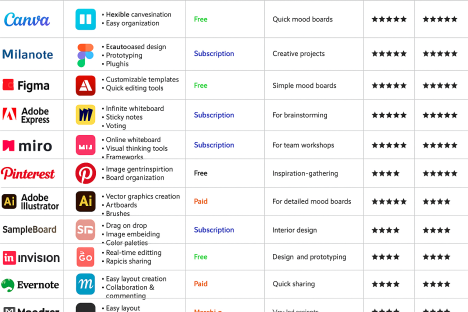
3. Moodboard â Simplified Excellence
True to its name, Moodboard focuses on delivering a streamlined mood boarding experience without unnecessary complications. This app prioritizes ease of use while maintaining powerful organizational capabilities.
Key Features:
- Clean, intuitive interface design
- Quick image import from various sources
- Customizable grid layouts
- Color palette extraction
- Social sharing capabilities
- Cross-platform synchronization
Pricing: Free with premium features available Best For: Beginners, quick mood board creation, simple projects
Moodboard excels at removing barriers between inspiration and creation. Its straightforward approach makes it accessible to users who might find more complex applications overwhelming while still providing professional-quality results.
4. Canva â The All-in-One Creative Suite
While primarily known as a graphic design platform, Canva offers robust mood boarding capabilities within its comprehensive creative toolkit. This versatility makes it particularly valuable for users who need integrated design solutions.
Key Features:
- Extensive template library with mood board options
- Built-in stock photo and element library
- Brand kit functionality for consistent styling
- Team collaboration features
- Integration with social media platforms
- Advanced design tools beyond mood boarding
Pricing: Free plan available; Canva Pro starts at $14.99/month Best For: Content creators, small businesses, integrated design workflows
Canva’s ecosystem approach means users can create mood boards and immediately transition to developing final designs using the same platform. This seamless workflow integration saves time and maintains visual consistency across projects.
5. Adobe Creative Cloud Express â Professional Power
Adobe’s entry into the simplified design space brings professional-grade capabilities to mood board creation. This platform leverages Adobe’s design expertise while remaining accessible to non-professionals.
Key Features:
- Integration with Adobe Creative Cloud ecosystem
- Professional design templates
- Advanced typography options
- Brand consistency tools
- High-resolution export capabilities
- Collaborative features
Pricing: Free plan available; Premium plans start at $9.99/month Best For: Design professionals, Adobe ecosystem users, high-quality outputs
The platform’s connection to Adobe’s broader creative suite makes it particularly valuable for professionals who use other Adobe products. Users can easily transfer elements between applications, maintaining design integrity throughout their workflow.
6. Figma â The Collaborative Powerhouse
Originally designed for UI/UX design, Figma has evolved into a versatile creative platform that excels at collaborative mood boarding. Its real-time collaboration features set it apart from traditional mood boarding applications.
Key Features:
- Real-time collaborative editing
- Vector-based design tools
- Component libraries for consistent elements
- Developer handoff capabilities
- Version history and commenting
- Plugin ecosystem for extended functionality
Pricing: Free for personal use; Professional plans start at $12/month per user Best For: Design teams, UI/UX projects, collaborative workflows
Figma’s strength in collaborative work makes it ideal for teams that need to iterate on mood boards together. The platform’s commenting and version control features ensure that creative feedback is captured and implemented effectively.
7. Notion â The Organizational Hybrid
Notion brings its renowned organizational capabilities to mood board creation, offering a unique approach that combines visual inspiration with comprehensive project documentation.
Key Features:
- Database integration for organizing inspiration
- Multimedia support including images, videos, and files
- Template sharing community
- Task and project management integration
- Advanced filtering and sorting options
- Cross-platform accessibility
Pricing: Free for personal use; Team plans start at $8/month per user Best For: Organized creatives, project documentation, comprehensive planning
Notion’s database approach to mood boarding allows for unprecedented organization and searchability. Users can tag, categorize, and cross-reference inspiration in ways that traditional mood board apps cannot match.
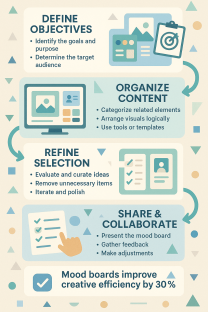
8. InVision â The Prototyping Professional
InVision extends its design and prototyping expertise to mood board creation, offering tools specifically designed for digital product development and user experience design.
Key Features:
- Integration with design workflow tools
- Collaborative feedback systems
- Version control for design iterations
- Presentation mode for client reviews
- Design system integration
- User testing capabilities
Pricing: Free plan available; Paid plans start at $7.95/month per user Best For: Digital product design, UX/UI teams, client presentations
InVision’s focus on digital product development makes it particularly valuable for teams working on apps, websites, and other digital experiences where mood boards need to integrate with broader design systems.
9. PurplePort â The Photography Specialist
Designed specifically for photography and modeling portfolios, PurplePort offers specialized mood boarding features tailored to visual storytelling and creative photography planning.
Key Features:
- Photography-focused templates
- Model and photographer networking
- Shoot planning integration
- Portfolio presentation tools
- Industry-specific categorization
- Professional networking features
Pricing: Free basic membership; Premium features available Best For: Photographers, models, fashion industry, visual storytelling
PurplePort’s specialization in photography makes it invaluable for fashion shoots, portrait sessions, and other photography projects where visual planning is crucial to success.
10. Evernote â The Note-Taking Classic
While not traditionally considered a mood board app, Evernote’s multimedia capabilities and organizational features make it a powerful tool for collecting and organizing visual inspiration alongside project notes.
Key Features:
- Multimedia note creation
- Web clipper for saving online inspiration
- Cross-platform synchronization
- Advanced search capabilities
- Tag-based organization
- Offline access
Pricing: Free plan available; Premium plans start at $7.99/month Best For: Research-heavy projects, mixed media inspiration, comprehensive documentation
Evernote’s strength lies in its ability to combine visual inspiration with contextual information, making it ideal for projects that require detailed research and documentation alongside visual elements.
11. VSCO â The Aesthetic Curator
Originally a photo editing app, VSCO has evolved into a comprehensive creative platform that excels at aesthetic curation and visual storytelling, particularly for lifestyle and artistic projects.
Key Features:
- Advanced photo editing tools
- Preset filters for consistent aesthetics
- Community discovery features
- Grid layout for visual planning
- Social sharing capabilities
- Mobile-first design
Pricing: Free with in-app purchases; VSCO Membership at $19.99/year Best For: Photography aesthetics, lifestyle branding, mobile creativity
VSCO’s emphasis on photographic aesthetics makes it particularly valuable for projects where image quality and visual consistency are paramount, such as brand development and lifestyle content creation.
12. Miro â The Digital Whiteboard
Miro transforms traditional whiteboarding into a digital experience that accommodates mood boarding alongside broader creative collaboration and ideation processes.
Key Features:
- Infinite canvas workspace
- Real-time collaboration
- Template library including mood board options
- Integration with productivity tools
- Video conferencing integration
- Advanced facilitation features
Pricing: Free plan available; Team plans start at $8/month per user Best For: Brainstorming sessions, team workshops, complex project planning
Miro’s whiteboard approach allows mood boards to exist within broader creative processes, making it ideal for teams that need to combine visual inspiration with strategic planning and ideation.
13. Dropmark â The Simple Collector
Dropmark focuses on simplicity and speed, offering a straightforward approach to collecting and organizing visual inspiration without overwhelming users with complex features.
Key Features:
- Drag-and-drop collection interface
- Automatic link preview generation
- Simple sharing options
- Clean, minimal design
- Quick capture tools
- Cross-platform availability
Pricing: Free plan available; Pro features for $5/month Best For: Quick inspiration collection, minimal interface preferences, simple sharing
Dropmark’s minimalist approach appeals to users who want powerful collection capabilities without the complexity of more feature-rich platforms.
14. Muzli â The Design Discovery Engine
Muzli serves as a discovery platform specifically designed for design professionals, offering curated design inspiration alongside mood boarding capabilities.
Key Features:
- Curated design inspiration feed
- Browser extension for easy saving
- Designer portfolio integration
- Trend identification and reporting
- Community-driven content
- Professional networking features
Pricing: Free with optional premium features Best For: Design professionals, trend research, industry inspiration
Muzli’s focus on design trends and professional development makes it particularly valuable for designers who need to stay current with industry developments while building project mood boards.
15. Eagle â The Digital Asset Manager
Eagle combines mood boarding with comprehensive digital asset management, offering powerful organizational tools for creatives who work with large collections of visual materials.
Key Features:
- Advanced tagging and categorization
- Bulk import and organization tools
- Color and similarity search
- Design inspiration feeds
- Team collaboration features
- Plugin ecosystem
Pricing: One-time purchase of $29.95 Best For: Digital asset management, large inspiration collections, professional organization
Eagle’s asset management focus makes it ideal for professionals who need to maintain organized libraries of inspiration alongside active project work.
Essential Features to Look for in Mood Board Apps

User Interface and Experience
The best mood board apps prioritize intuitive design that doesn’t interfere with the creative process. Look for applications with clean, uncluttered interfaces that allow your inspiration to take center stage. Drag-and-drop functionality should feel natural, and navigation should be logical enough that you can focus on creativity rather than learning complex controls.
Modern mood board apps should offer responsive design that works seamlessly across devices. Whether you’re collecting inspiration on your phone during a commute or building detailed boards on a desktop computer, the experience should remain consistent and efficient.
Collaboration Capabilities
Creative work increasingly happens in teams, making collaboration features essential for many users. Look for apps that offer real-time editing, commenting systems, and permission controls that allow you to share boards with clients, teammates, or stakeholders while maintaining appropriate access levels.
Advanced collaboration features might include version history, which allows teams to track changes and revert to previous iterations, and notification systems that keep team members informed of updates and changes.
Import and Export Options
Flexibility in how you get content into and out of your mood board app significantly impacts its utility in broader creative workflows. The best apps offer multiple import options, including web browser extensions, direct upload capabilities, and integration with cloud storage services.
Export capabilities should accommodate various use cases, from high-resolution images suitable for client presentations to web-friendly formats for online sharing. Some applications also offer integration with other creative software, allowing seamless transitions between mood boarding and execution phases.
Organization and Search Features
As your collection of inspiration grows, organization becomes crucial. Look for apps that offer robust tagging systems, folder structures, and search capabilities that help you find specific content quickly. Advanced search features might include color-based searching, which can help you find images with specific color palettes, or similarity searching that finds visually related content.
Mobile Optimization
Inspiration strikes at unexpected moments, making mobile optimization crucial for mood board apps. The best applications offer full-featured mobile experiences that allow you to capture, organize, and share inspiration regardless of your device. Mobile apps should include features like camera integration for capturing real-world inspiration and offline access for working without internet connectivity.
How to Choose the Right Mood Board App for Your Needs
Assess Your Creative Workflow
Before selecting a mood board app, carefully evaluate how mood boarding fits into your broader creative process. If you work primarily on quick, simple projects, a streamlined app like Moodboard might be ideal. However, if your projects involve complex collaboration and detailed documentation, a more comprehensive solution like Notion or Milanote might better serve your needs.
Consider whether you need integration with other creative tools. If you use Adobe Creative Suite regularly, Adobe Creative Cloud Express might offer valuable workflow benefits. Similarly, if you’re already invested in Microsoft or Google ecosystems, look for apps that integrate well with those platforms.
Evaluate Collaboration Requirements
Solo creatives have different needs than teams working on complex projects. If you regularly share work with clients or collaborate with teammates, prioritize apps with strong sharing and collaboration features. Consider whether you need real-time collaboration, comment systems, and permission controls.
For client-facing work, presentation features become important. Some apps excel at creating polished presentations from mood boards, while others focus more on the creation and organization process.
Consider Budget and Pricing Models
Mood board apps use various pricing models, from completely free applications to subscription-based professional tools. Evaluate not just the initial cost but the long-term value proposition. Free apps might be suitable for personal use but lack features needed for professional work.
Consider whether you prefer subscription-based pricing that includes regular updates and support, or one-time purchases that provide long-term access without ongoing costs. Factor in the cost of any additional features or team licenses you might need as your usage grows.
Test Integration Capabilities
Modern creative workflows often involve multiple applications and platforms. Test how well potential mood board apps integrate with your existing tools. This might include social media platforms for sharing, cloud storage services for file management, or design software for project execution.
Some apps offer extensive integration ecosystems through APIs or plugin systems, while others focus on standalone functionality. Choose based on how isolated or integrated you want your mood boarding process to be.
Best Practices for Creating Effective Mood Boards
Define Clear Objectives
Before beginning any mood board, establish clear objectives for what you hope to achieve. Are you exploring color palettes for a brand identity? Collecting architectural inspiration for a space design? Defining the aesthetic for a photography project? Clear objectives guide your collection process and help you evaluate the effectiveness of your final board.
Document these objectives within your mood board app, either as text notes or dedicated sections. This documentation helps maintain focus during the collection process and provides context for anyone else who views your board.
Organize with Intentional Structure
Effective mood boards balance inspiration with organization. Develop consistent organizational systems that work across projects. This might involve standardized naming conventions, consistent tagging systems, or template structures that you can reuse for similar project types.
Consider creating master boards that serve as repositories for ongoing inspiration, with project-specific boards that pull from these larger collections. This approach helps maintain comprehensive inspiration libraries while keeping project work focused and relevant.
Balance Variety with Cohesion
The best mood boards strike a balance between diverse inspiration and cohesive vision. Include enough variety to stimulate creative thinking while maintaining visual relationships that communicate a clear direction. This might involve varying textures while maintaining a consistent color palette, or exploring different compositional approaches within a defined stylistic framework.
Regularly review your boards to ensure they maintain this balance. Remove elements that no longer contribute to the overall vision, and add new inspiration that enhances or refines your direction.
Include Contextual Information
Visual elements alone don’t always communicate complete ideas. Include contextual information such as source attribution, technical specifications, or explanatory notes that help others understand your inspiration choices. This context becomes particularly important when sharing boards with team members or clients who weren’t involved in the collection process.
Many mood board apps allow you to add text annotations, links to source materials, or detailed descriptions alongside visual elements. Use these features to create comprehensive documentation that supports your creative vision.
Regular Review and Refinement
Mood boards should evolve throughout the creative process. Regularly review and refine your boards, removing elements that no longer serve your vision and adding new inspiration that supports project development. This iterative approach ensures that your mood boards remain relevant and useful throughout extended creative processes.
Set up regular review schedules, particularly for long-term projects. This might involve weekly reviews for active projects or monthly assessments for ongoing inspiration collections.
Advanced Mood Board Techniques and Tips
Color Psychology and Palette Development
Understanding color psychology enhances the effectiveness of your mood boards, particularly for projects involving brand development or emotional communication. Different colors evoke specific psychological responses, and intentional color selection can reinforce your project’s emotional objectives.
Use mood board apps with color extraction features to identify and document specific color values from your inspiration images. Create dedicated color palette sections within your boards, and consider how different color combinations might affect viewer perception of your final project.
Typography and Text Integration
While mood boards traditionally focus on visual elements, typography plays a crucial role in many creative projects. Include typography inspiration in your mood boards, considering both decorative and functional text applications. This might involve collecting examples of specific typefaces, text layouts, or typographic treatments that align with your project vision.
Some mood board apps allow you to experiment with typography directly within the application, while others work better for collecting typographic inspiration that you’ll apply in other design software.
Texture and Material Exploration
Physical textures and materials significantly impact viewer perception, even in digital applications. Include texture inspiration in your mood boards, considering how different surface treatments, patterns, or material properties might influence your project outcomes.
High-resolution images that clearly show texture details work best for this type of inspiration. Consider creating dedicated sections for different texture categories, such as natural materials, manufactured surfaces, or fabric treatments.
Lighting and Atmospheric Considerations
Lighting dramatically affects how visual elements are perceived, making it an important consideration for many creative projects. Include lighting inspiration that demonstrates different moods, times of day, or atmospheric conditions relevant to your project.
This technique proves particularly valuable for photography, interior design, or any project where environmental conditions significantly impact the final result. Document not just the visual appearance but also the technical aspects of lighting setups when relevant.
Scale and Proportion Studies
Understanding scale and proportion relationships helps translate mood board inspiration into practical applications. Include examples that demonstrate different approaches to scale, whether in typography, spatial relationships, or object sizing.
This consideration becomes particularly important when mood boards will inform three-dimensional work such as interior design or product development, where physical scale relationships directly impact functionality and user experience.
Common Mood Board Mistakes to Avoid
Overwhelming Visual Complexity
One of the most common mistakes in mood board creation involves including too many disparate elements without clear visual relationships. While diversity in inspiration can be valuable, boards that lack visual cohesion fail to communicate clear direction and can confuse rather than inspire.
Regularly edit your boards to maintain focus. If you’re drawn to inspiration that doesn’t fit your current board’s direction, consider creating separate boards for different aesthetic explorations rather than forcing unrelated elements together.
Lack of Clear Purpose
Mood boards created without clear objectives often become collection exercises rather than strategic creative tools. Without defined goals, it becomes difficult to evaluate whether inspiration supports your project needs or simply appeals to personal taste.
Document your objectives clearly, and regularly assess whether your board effectively communicates your intended direction. This assessment becomes particularly important when sharing boards with others who need to understand your creative vision.
Ignoring Technical Constraints
Beautiful inspiration that cannot be practically implemented wastes time and resources. Consider technical constraints such as budget limitations, production capabilities, or platform requirements when selecting inspiration. This doesn’t mean limiting creativity, but rather ensuring that your inspiration can realistically inform practical solutions.
Include notes about technical considerations alongside visual inspiration. This might involve noting color specifications for print projects, resolution requirements for digital applications, or material availability for physical products.
Poor Organization Systems
Inconsistent organization makes mood boards difficult to navigate and reduces their effectiveness as reference tools. Develop organization systems early in your process and maintain them consistently across projects.
This includes consistent naming conventions, standardized tagging systems, and logical folder structures. Good organization becomes increasingly important as your inspiration collections grow and you work on multiple projects simultaneously.
Insufficient Source Documentation
Failing to document inspiration sources creates legal and practical problems, particularly for commercial projects. Always include source attribution for inspiration elements, and understand the licensing requirements for any content you collect.
Many mood board apps include features for automatically capturing source information when you save content. Use these features consistently, and supplement them with additional context when necessary.
Future Trends in Mood Board Applications
AI-Powered Inspiration Discovery
Artificial intelligence increasingly influences mood board applications, offering automated inspiration discovery based on project requirements or existing board content. These systems can suggest relevant content, identify visual patterns, and even generate original elements that complement existing inspiration.
Future developments likely include more sophisticated AI analysis that can understand style preferences, predict project needs, and automate routine organization tasks while preserving creative control.
Virtual and Augmented Reality Integration
Emerging VR and AR technologies offer new possibilities for mood board creation and presentation. These technologies allow for three-dimensional mood boarding experiences and immersive presentation formats that help clients and team members better understand spatial or environmental design concepts.
Early implementations focus on architecture and interior design applications, but broader creative applications will likely develop as the technology becomes more accessible.
Enhanced Collaboration Features
Future mood board applications will likely offer more sophisticated collaboration capabilities, including real-time communication integration, advanced permission systems, and AI-assisted feedback compilation. These features address the growing need for remote creative collaboration and distributed team workflows.
Integration with Production Workflows
Tighter integration between mood boarding and production tools will streamline the transition from inspiration to execution. This might include automatic asset generation, specification documentation, or direct connections to manufacturing and production systems.
Sustainability and Ethics Focus
Growing awareness of sustainability and ethical considerations in creative work will influence mood board applications. Future tools may include features for tracking the environmental impact of inspiration choices, promoting sustainable alternatives, or highlighting ethical sourcing considerations.
Conclusion: Finding Your Perfect Creative Companion
The world of mood board applications offers unprecedented opportunities for creative organization and inspiration management. Whether you’re a professional designer working on complex client projects or a creative enthusiast exploring personal aesthetic development, the right mood board app can significantly enhance your creative process.
Success with mood board applications depends on matching tool capabilities with your specific needs, workflows, and creative objectives. The applications reviewed in this guide each offer unique strengths, from Pinterest’s vast inspiration database to Milanote’s project management integration to Notion’s organizational power.
Remember that the best mood board app is the one you’ll actually use consistently. Consider starting with free versions of applications that interest you, testing their interfaces and features with real projects before committing to paid plans. Many creatives find value in using multiple applications for different purposes, such as Pinterest for discovery, Milanote for project development, and Canva for presentation creation.
The creative landscape continues evolving, with new technologies and approaches constantly emerging. Stay open to experimenting with new tools and techniques while maintaining focus on what serves your creative objectives most effectively. Your perfect mood board application might be one that doesn’t exist yet, but the current landscape offers powerful options for every creative need and budget.
Most importantly, remember that mood board applications are tools to support creativity, not replace it. The most sophisticated app cannot substitute for creative vision, aesthetic sensitivity, and the hard work of developing and executing creative ideas. Use these tools to enhance and organize your creative process, but never let them limit your imagination or artistic exploration.
As you explore the mood board applications discussed in this guide, consider how each might fit into your broader creative ecosystem. The best choice will seamlessly integrate with your existing workflows while opening new possibilities for creative expression and organization. Whether you choose a simple, focused tool or a comprehensive creative platform, the right mood board app will become an invaluable partner in your creative journey.
